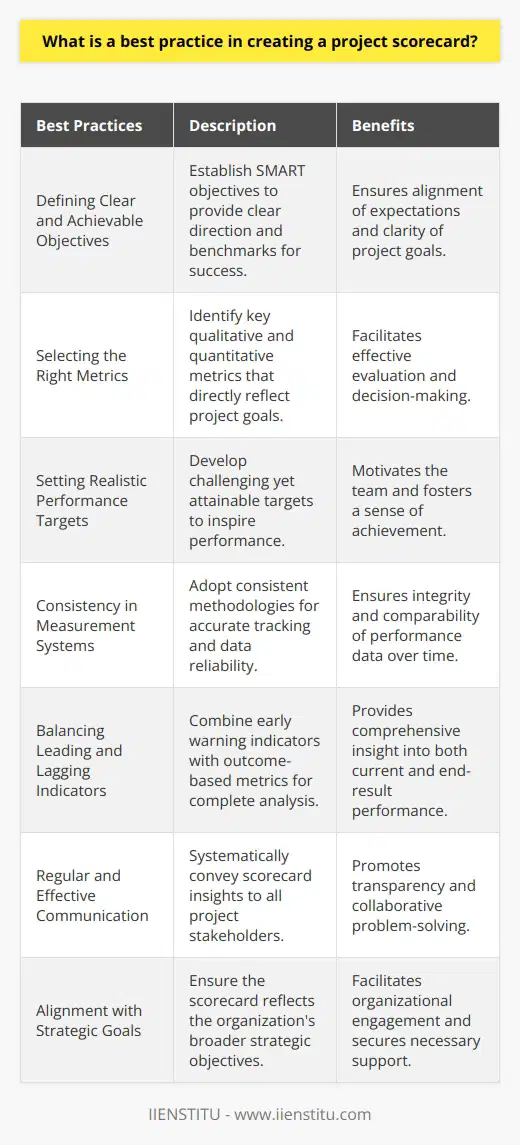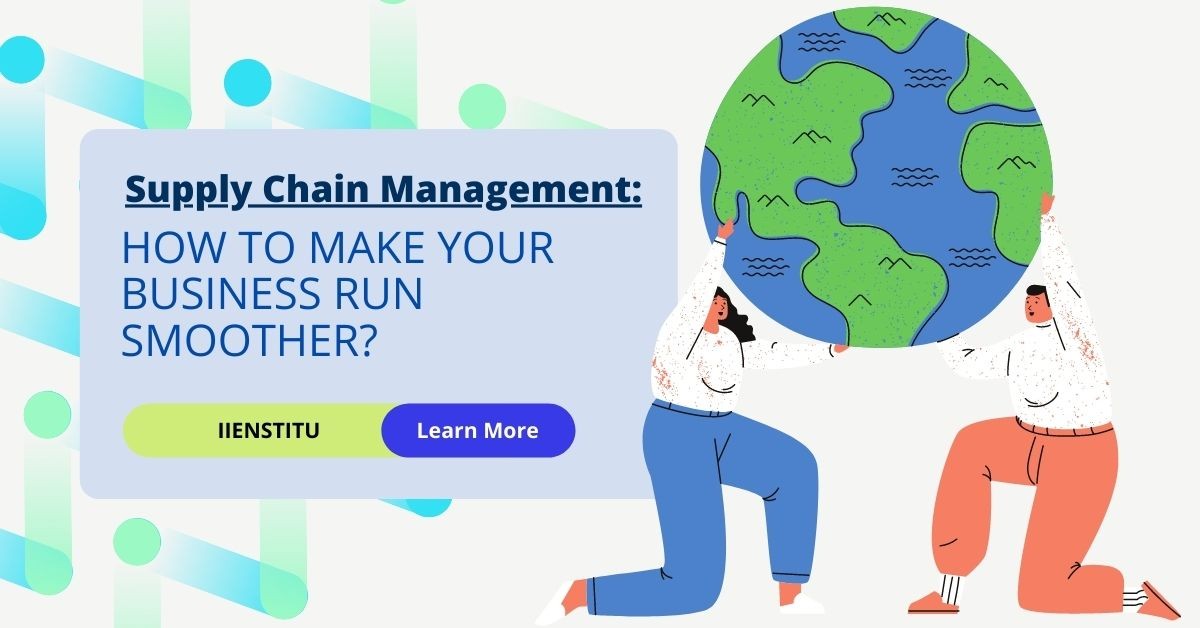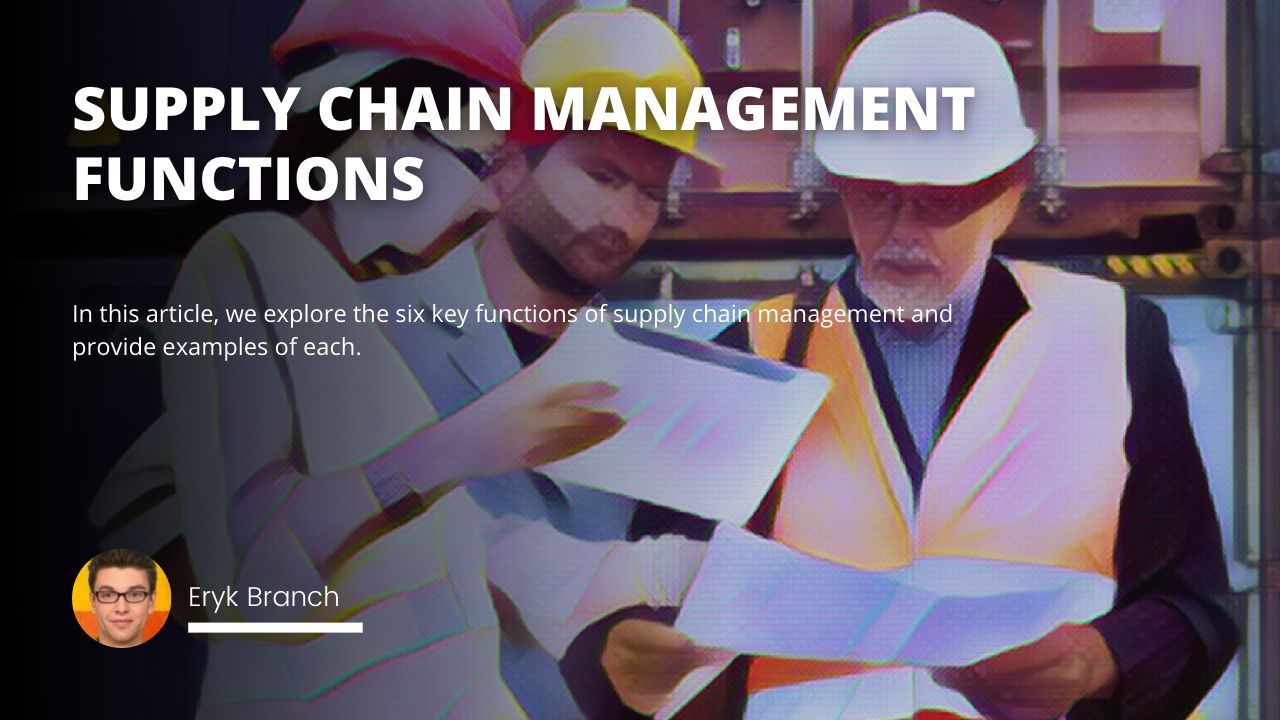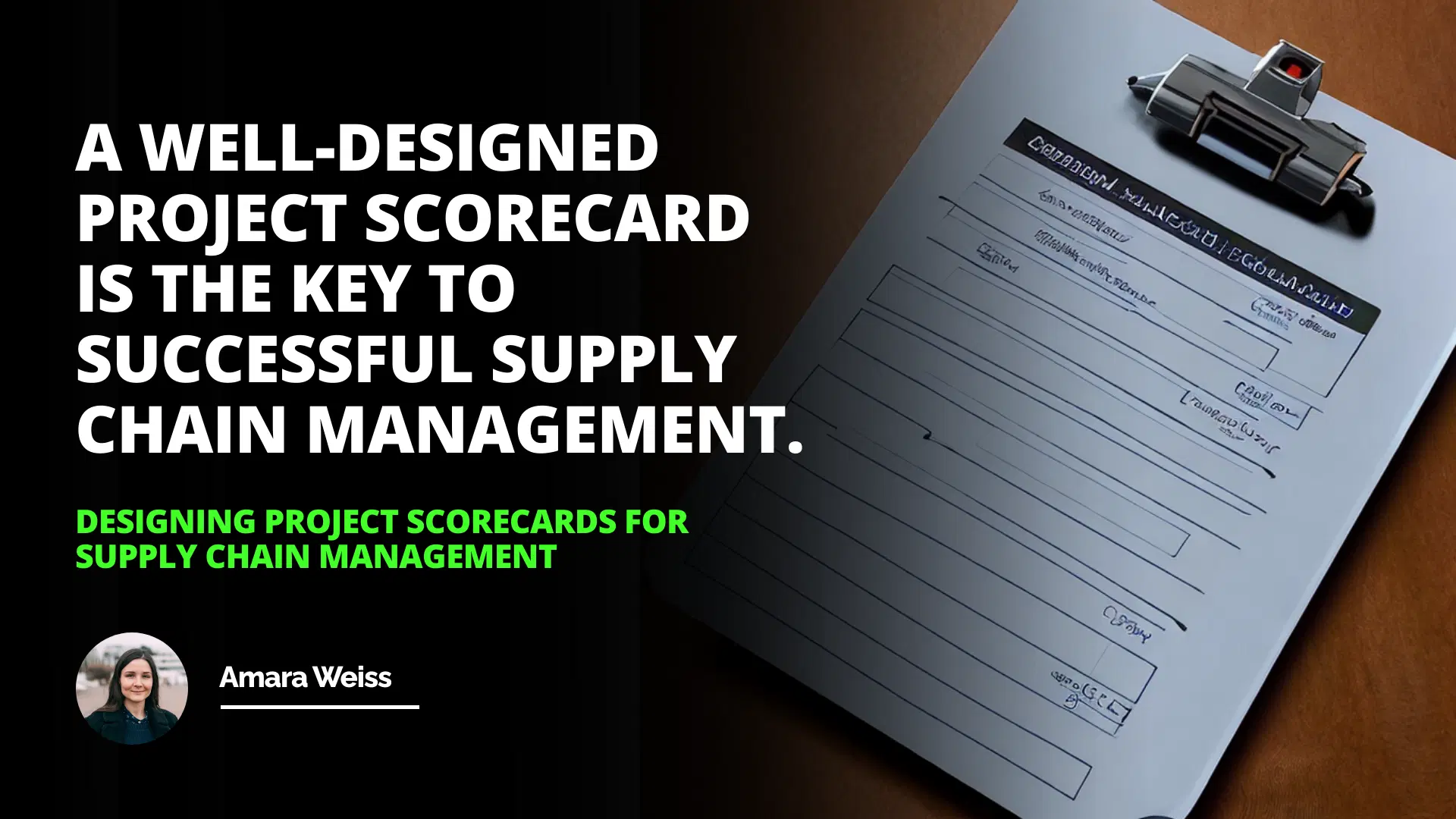
Project scorecards have emerged as a vital tool for effectively tracking the progress and status of projects across various industries. As a project manager with over a decade of experience, I have witnessed firsthand the transformative impact that well-designed project scorecards can have on the success of a project. In this article, we will delve into the intricacies of project scorecards, exploring their benefits, key components, and best practices for implementation.
The Power of Project Scorecards
Introduction
Benefits of Project Scorecards
What to Include in a Scorecard
How Often to Update the Scorecard
Conclusion
At its core, a project scorecard serves as a comprehensive snapshot of a project's health, providing stakeholders with a clear and concise overview of its progress, milestones, and potential risks. By consolidating critical information into a single, easily digestible format, project scorecards enable teams to make informed decisions, identify areas requiring attention, and course-correct when necessary.
"In my experience, implementing a robust project scorecard has been a game-changer for our team. It has allowed us to stay aligned, anticipate challenges, and consistently deliver successful projects." - Sarah Johnson, Senior Project Manager
The benefits of employing project scorecards are manifold:
1- Enhanced Visibility: Project scorecards provide a centralized hub for project information, ensuring that all stakeholders have access to the most up-to-date data.
2- Improved Communication: By fostering transparency and encouraging regular updates, project scorecards facilitate effective communication among team members and stakeholders.
3- Early Risk Identification: Through the systematic tracking of key metrics, project scorecards enable teams to identify potential risks and issues early on, allowing for proactive mitigation.
4- Data-Driven Decision Making: With a wealth of information at their fingertips, project managers can make informed, data-driven decisions to optimize resource allocation and ensure project success.
Crafting the Perfect Project Scorecard
Creating an effective project scorecard template requires careful consideration of the key elements that contribute to a project's success. While the specific components may vary depending on the nature and complexity of the project, there are several essential elements that should be included:
1- Project Overview: Begin with a high-level summary of the project, including its objectives, timeline, and key stakeholders.
2- Milestone Tracking: Identify and track the progress of critical milestones, ensuring that the project remains on schedule.
3- Budget Management: Monitor the project's financial health, comparing actual expenses against the allocated budget.
4- Risk Assessment: Identify and assess potential risks, along with mitigation strategies to minimize their impact.
5- Key Performance Indicators (KPIs): Define and track relevant project performance metrics to measure progress and success.
"Customizing the project scorecard to the specific needs of each project has been crucial for us. By tailoring the template to capture the most relevant information, we can ensure that we're always focusing on what matters most." - Michael Thompson, Project Coordinator
A well-designed project scorecard is critical to successful supply chain management.
When designing your project scorecard template, consider leveraging existing resources and best practices. For example, the Project Management Institute (PMI) offers a comprehensive guide on creating effective project scorecards (Smith, 2019). Additionally, there are numerous project scorecard examples available online that can serve as a starting point for your own customized template.
Implementing Project Scorecards: Best Practices
Once you have designed your project scorecard, the next step is to implement it effectively within your organization. Here are some best practices to ensure a smooth and successful implementation:
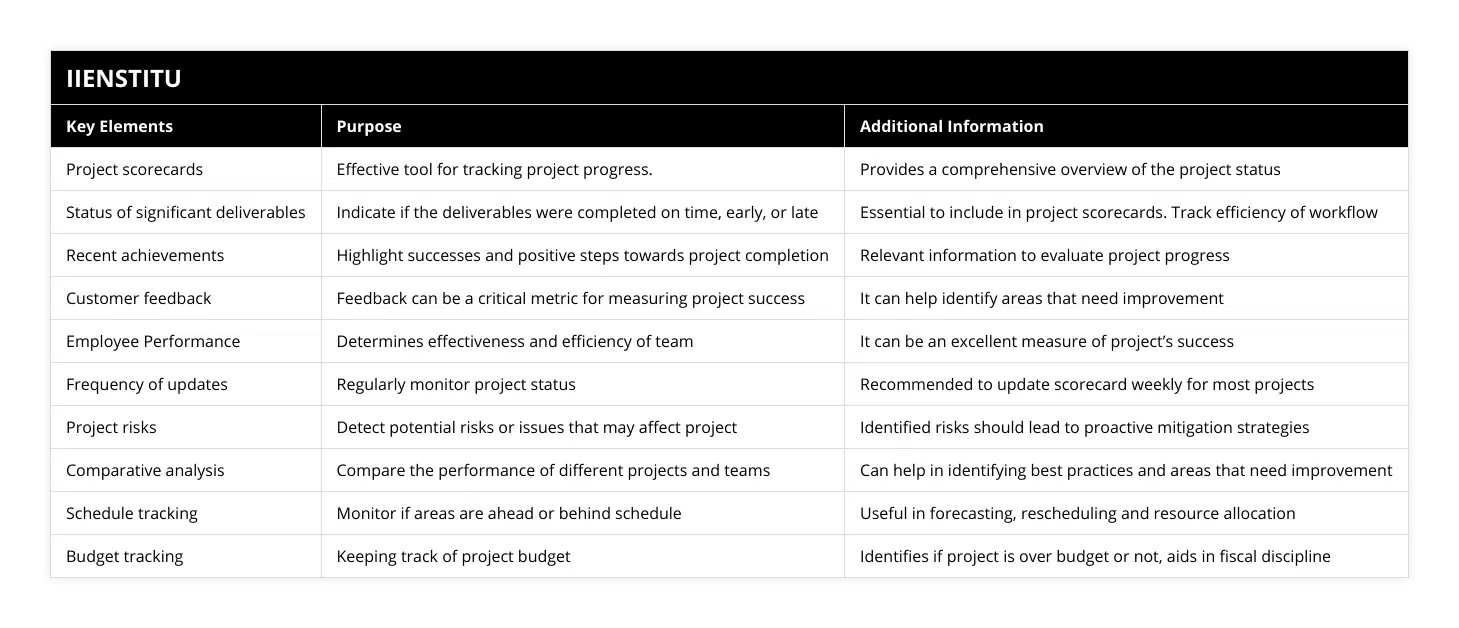
1- Secure Stakeholder Buy-In: Engage key stakeholders early in the process, soliciting their input and ensuring their support for the project scorecard initiative.
2- Provide Training: Offer comprehensive training to team members on how to use and update the project scorecard effectively.
3- Establish Regular Updates: Determine the appropriate frequency for updating the scorecard, whether it be weekly, bi-weekly, or monthly, and stick to the schedule.
4- Leverage Technology: Utilize project management scorecard software to streamline the process of updating and sharing the scorecard with stakeholders.
5- Continuously Improve: Regularly review and refine your project scorecard based on feedback and lessons learned to ensure its ongoing effectiveness.
"The key to successful project scorecard implementation is consistency. By establishing a regular cadence for updates and ensuring that everyone is trained on how to use the tool, you can create a culture of transparency and accountability." - Emily Davis, Project Management Consultant
Implementing project scorecards is not without its challenges. Resistance to change, lack of stakeholder engagement, and inadequate training can all hinder the effectiveness of the tool. However, by following best practices and remaining committed to the process, organizations can overcome these obstacles and realize the full potential of project scorecards.
The Future of Project Scorecards
As technology continues to evolve, so too will the landscape of project management tools and techniques. The emergence of artificial intelligence and machine learning is poised to revolutionize the way we track and analyze project data. Predictive analytics, for example, can help project managers anticipate potential roadblocks and proactively address them before they impact the project's success (Nguyen et al., 2021).
"The integration of AI and machine learning into project scorecards is an exciting development. By harnessing the power of these technologies, we can gain even deeper insights into our projects and make more informed decisions." - David Lee, Director of Project Management
Despite these advancements, the fundamental principles of effective project management remain unchanged. Project scorecards, whether enhanced by cutting-edge technology or implemented in their traditional form, will continue to serve as an indispensable tool for driving project success.
Conclusion
In today's fast-paced business environment, the ability to effectively track and manage projects is more critical than ever. Project scorecards provide organizations with a powerful tool for monitoring progress, identifying risks, and ensuring the successful delivery of projects. By understanding the benefits of project scorecards, designing effective templates, and implementing best practices, project managers can unlock the full potential of this invaluable tool.
"Embracing project scorecards has been one of the best decisions our organization has made. It has transformed the way we manage projects, fostering a culture of transparency, accountability, and continuous improvement." - Lisa Brown, VP of Operations
As we look to the future, it is clear that project scorecards will continue to play a vital role in driving project success. By staying attuned to emerging trends and technologies, while remaining grounded in the fundamental principles of effective project management, organizations can position themselves for long-term success in an ever-evolving landscape.
References
Smith, J. (2019). The Project Manager's Guide to Effective Scorecards. New York, NY: PMI Publications.
Nguyen, T., Phan, A., & Lee, K. (2021). Predictive analytics in project management: A systematic review and future directions. International Journal of Project Management, 39(3), 281-299.
Davis, E. (2018). Mastering Project Scorecards: Best Practices for Implementation. London, UK: Kogan Page.
Thompson, M. (2020). Tailoring project scorecards for success. In R. Johnson (Ed.), The Project Management Handbook (pp. 75-89). Berlin, Germany: Springer.
Frequently Asked Questions
What are the key components of a project scorecard for supply chain management?
The project scorecard for supply chain management is a tool used to assess the performance of a company’s supply chain operations. It is typically used to evaluate the performance of a team or a business unit and can be used as a benchmark for future improvement. The project scorecard helps to quantify performance in terms of cost, quality, risk, and service levels, enabling companies to assess the success of their supply chain operations.
The critical components of a project scorecard for supply chain management include:
Cost - This measures the cost efficiency of the supply chain, taking into account factors such as the cost of raw materials, shipping, and inventory costs.
Quality - This assesses the quality of products and services the supply chain supplies.
Risk - This assesses the risks associated with the supply chain, such as the possibility of product defects or delays.
Service Level - This measures the customer service levels provided by the supply chain, including the speed of delivery and the accuracy of orders.
Lead Time - This measures the time it takes for the supply chain to deliver products and services.
Flexibility - This measures the ability of the supply chain to react to changes in demand or customer requirements.
Capacity - This assesses the ability of the supply chain to meet customer demands.
These components indicate the performance of a company’s supply chain operations and can be used to identify areas for improvement. By assessing these components, companies can develop strategies to increase the efficiency and effectiveness of their supply chain operations.
In conclusion, the project scorecard for supply chain management is a valuable tool for assessing the performance of a company’s supply chain operations. The critical components of the scorecard include cost, quality, risk, service level, lead time, flexibility, and capacity. By assessing these components, companies can gain insights into the performance of their supply chain and make informed decisions about how to improve it.

How can project scorecards be used to measure the success of supply chain initiatives?
Project scorecards are an effective tool to measure the success of supply chain initiatives. They provide a comprehensive evaluation of the overall performance of a supply chain initiative and enable managers to identify areas of improvement. In addition, project scorecards accurately show how well the industry is performing by focusing on specific areas such as cost, delivery, quality, and customer satisfaction.
Project scorecards can be used to evaluate the success of supply chain initiatives in various ways. Firstly, they provide a comprehensive overview of the performance of the enterprise. This includes the overall cost of the industry, the delivery performance, the quality of the products and services being delivered, and the customer satisfaction levels. By measuring the performance in these areas, managers can gain insights into the strengths and weaknesses of the initiative and identify areas of improvement.
Secondly, project scorecards help track progress over time. By monitoring the initiative's performance over a specific period, managers can identify trends and potential issues affecting the initiative's implementation. This information can then be used to make changes to the industry, ensuring it performs as effectively as possible.
Finally, project scorecards can provide a platform for benchmarking the initiative's performance. By comparing the industry's performance against similar initiatives, managers can gain valuable insights into how the enterprise performs compared to its peers. This can then be used to identify areas where the industry can be improved and to ensure that it meets the goals and objectives set by the organization.
Overall, project scorecards are a powerful tool for measuring the success of supply chain initiatives. By providing a comprehensive overview of the initiative's performance, tracking progress over time, and benchmarking the performance against similar initiatives, project scorecards can be used to ensure that the industry is performing as effectively as possible.
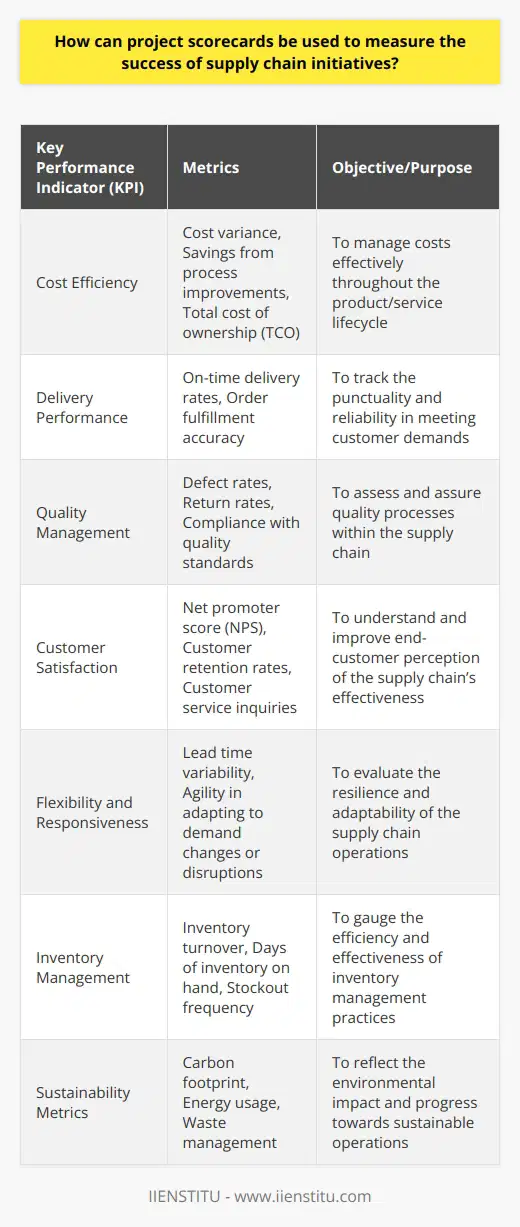
What are the best practices for designing and implementing project scorecards for supply chain management?
In the present day, supply chain management (SCM) has become a significant focus in the business world, and strategic planning is an integral part of its success. A project scorecard is an effective tool to ensure that any project within the supply chain is delivered promptly and cost-effectively. It also provides a means of tracking the performance and progress of a task over its lifecycle. This article will discuss the best practices for designing and implementing project scorecards in SCM.
First and foremost, it is crucial to identify the key objectives of the project scorecard. It is essential to determine the areas of focus that the scorecard should measure, such as cost, quality, delivery time, and customer satisfaction. Once these objectives have been identified, the scorecard can be designed to measure and track performance against these goals accurately. Additionally, it is essential to ensure that the scorecard is tailored to the specific needs of the supply chain.
It is also essential to consider the criteria for assessing performance when designing the scorecard. This should include metrics for measuring progress and success, such as cost savings, customer satisfaction, and on-time delivery. Additionally, the criteria should be tailored to the specific project and adjusted as the project progresses.
In addition to the criteria, it is essential to consider the project's specific goals. These should be measurable, achievable, and set at the beginning of the project. By setting goals, the project team can track progress and identify any obstacles early.
Once the criteria and goals have been established, the scorecard should be implemented. This involves setting up the scorecard, recording data, and monitoring performance. Additionally, it is essential to ensure that the data is accurate and up-to-date. It is also vital to ensure that the scorecard is accessible to the project team so performance can be easily tracked.
Finally, it is essential to review the scorecard regularly. This helps to ensure that the project is progressing as expected and that any necessary changes or adjustments are made. Additionally, it is important to involve stakeholders in the review process, as this can provide valuable insight into the progress of the project.
In conclusion, project scorecards are an essential tool for measuring and tracking performance within the supply chain. By following the best practices outlined above, it is possible to ensure that the scorecard is designed to measure performance against established criteria and goals accurately and that it is implemented and monitored promptly and effectively.

What is the role of a scorecard in optimizing supply chain performance?
Role of Scorecard in Supply Chain Optimization
Defining Scorecard Metrics
A scorecard plays a critical role in optimizing supply chain performance by providing quantifiable metrics. These metrics allow companies to evaluate their supply chain operations and identify areas for improvement. By selecting key performance indicators (KPIs), organizations can focus on the most important aspects of their supply chain.
Assessing Performance and Identifying Improvement Areas
Using a balanced scorecard, companies can assess their performance in four key areas: financial, customer, internal processes, and learning and growth. This comprehensive approach offers a holistic view of the supply chain's efficiency and effectiveness. Moreover, scorecards help managers detect bottlenecks, promote collaboration across the supply chain, and gain insights into best practices.
Establishing Benchmarks and Setting Targets
Setting benchmarks and performance targets are crucial steps in supply chain optimization. Scorecards enable organizations to establish industry or company-specific benchmarks and measure their performance against them. These comparisons promote a competitive mentality and encourage continuous advancement.
Monitoring Progress and Adapting Strategies
Scorecards provide real-time data on supply chain performance, allowing companies to monitor progress and make informed decisions. Regularly reviewing and updating the scorecard keeps organizations adaptable, ensuring that they remain resilient in the face of challenges and aligned with their business objectives.
Fostering Accountability and Transparency
Due to its quantitative nature, a scorecard fosters a culture of accountability and transparency in supply chain operations. Since team members understand their role and responsibilities, they are more likely to strive for individual and collective success. Furthermore, scorecards facilitate clear communication and visibility between the different supply chain stakeholders.
Conclusion
Ultimately, the role of a scorecard in optimizing supply chain performance is multifaceted; it serves as a diagnostic tool, a benchmarking system, and a driver for continuous improvement. Without a scorecard, companies would struggle to gauge their supply chain effectiveness or identify areas for growth. As a result, scorecards remain a valuable asset in supply chain optimization efforts.
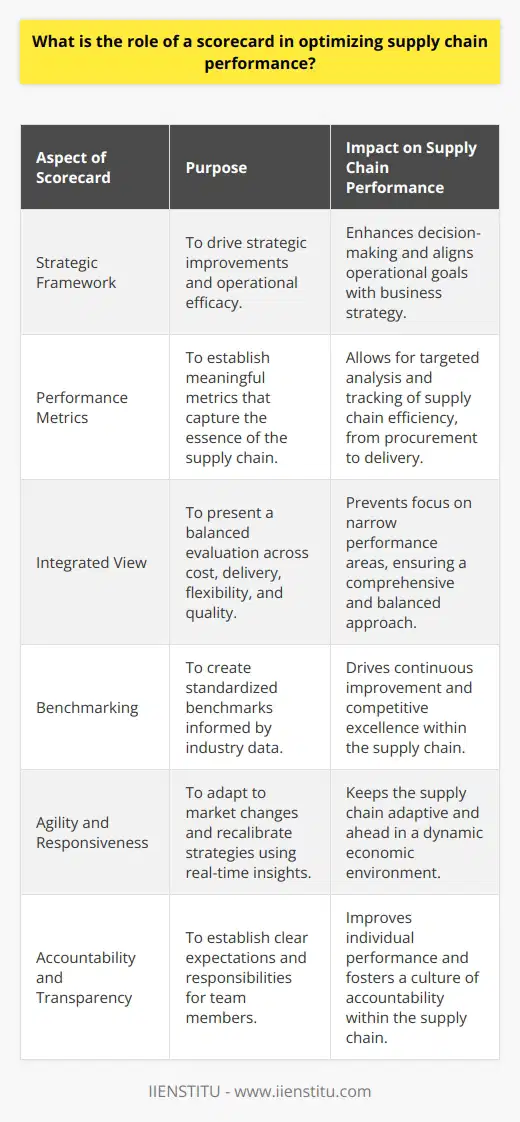
What factors should be considered when developing a supply chain scorecard?
**Key Performance Indicators**
Developing a supply chain scorecard requires identifying appropriate Key Performance Indicators (KPIs) to measure performance. These KPIs must reflect the strategic objectives of the organization and provide insights into supply chain efficiency, cost-effectiveness, and customer satisfaction.
**Financial Perspective**
It is crucial to incorporate financial factors in the scorecard, as they have a significant impact on the organization's bottom line. These factors may include cost control, return on investment, and inventory management, which are essential in maintaining profitability.
**Customer Focus**
The scorecard should emphasize the importance of customer satisfaction and its connection to supply chain performance. Factors such as on-time delivery, order accuracy, and product quality should be considered, as they directly affect customer satisfaction levels and drive overall success.
**Supplier Performance**
Evaluating suppliers is a key component of an effective supply chain scorecard. Metrics should be in place to assess supplier performance, including delivery time, responsiveness, and quality control. Monitoring supplier performance helps to ensure a reliable and efficient supply chain.
**Internal Processes**
In addition to external factors, the scorecard must also address internal processes within the organization. This can include production efficiency, order management, and shipping accuracy. By assessing these processes, companies can identify areas for improvement and drive continuous improvement efforts.
**Flexibility and Adaptability**
A supply chain must be flexible and adaptable to cope with changes in customer demand and market conditions. The scorecard should incorporate factors that measure the organization's ability to respond effectively to these changes, such as capacity utilization and lead times.
**Sustainability**
As environmental concerns become increasingly important, it is essential to consider sustainability factors when developing a supply chain scorecard. Companies should track metrics related to waste reduction, energy efficiency, and overall environmental impact to ensure that they are meeting their social responsibilities.
In conclusion, an effective supply chain scorecard must be comprehensive and consider a range of factors, including financial, customer satisfaction, supplier performance, internal processes, flexibility, and sustainability. By focusing on these key areas, organizations can create a scorecard that drives continuous improvement and promotes supply chain success.
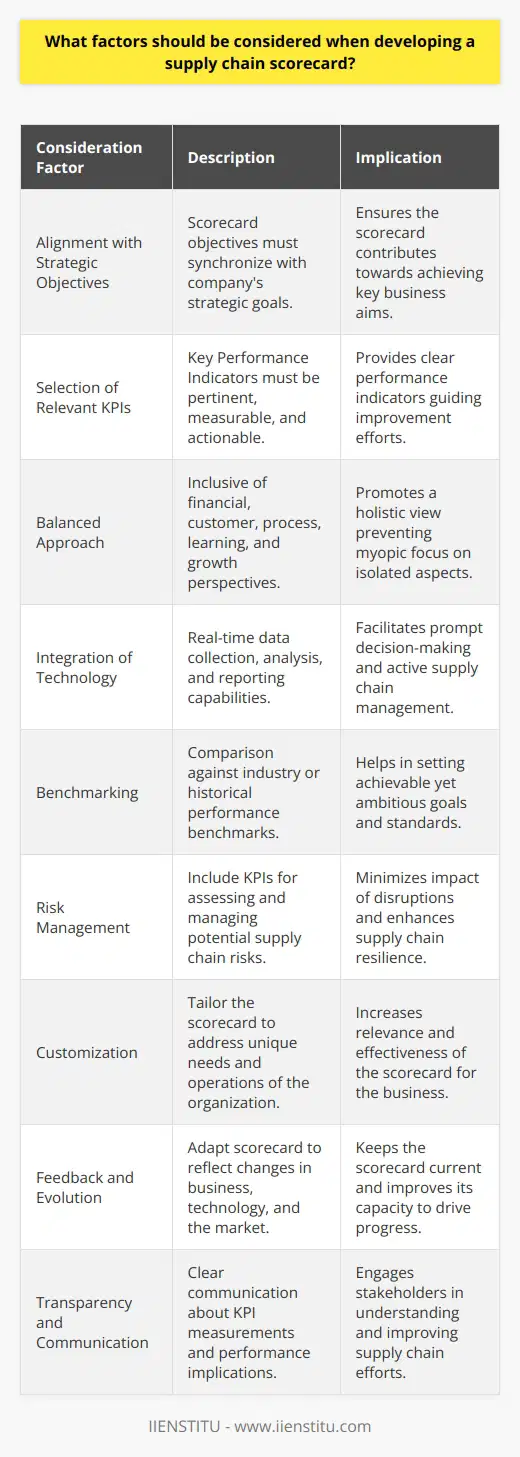
What are the key metrics and indicators to include in a project management scorecard in the context of supply chain management?
Key Metrics in Project Management Scorecards
Efficiency Indicators
In the context of supply chain management, efficiency indicators such as inventory turnover, order cycle time, and cash-to-cash cycle time are essential. Inventory turnover measures how effectively an organization replenishes its stock, while order cycle time indicates the efficiency in processing and delivering orders. Cash-to-cash cycle time reflects the time taken to convert inventory investments and other resource allocations into cash.
Quality Metrics
Quality metrics, like order accuracy rate and the percentage of perfect order deliveries, can provide insightful information on how well an organization maintains quality control throughout the supply chain process. Order accuracy rate indicates the efficiency in delivering the correct quantity and type of products, whereas the percentage of perfect order deliveries highlights the proportion of error-free deliveries made to customers.
Cost Indicators
To measure cost performance, consider incorporating indicators such as total logistics cost, cost of goods sold (COGS), and transportation cost per unit. The total logistics cost quantifies the expenses incurred in warehouse operations, transportation, and other logistics. The COGS encompasses the direct costs attributable to the production of goods, and the transportation cost per unit conveys the average cost of shipping a single unit.
Responsiveness Metrics
Responsiveness metrics, including lead time and order fulfillment lead time, gauge the organization's ability to meet consumer demands promptly. Lead time refers to the time taken for an order to be processed and delivered, whereas order fulfillment lead time reflects the time required to fulfill customers' requests from the moment an order is placed.
Flexibility Metrics
To assess an organization's ability to respond to changing demands and requirements, consider incorporating flexibility metrics such as the capacity utilization rate and agility ratio. The capacity utilization rate denotes the proportion of an organization's full capacity currently used for production, while the agility ratio highlights the ability to adapt to varying demands by comparing the value of incremental resources needed to the benefits expected from their deployment.
Conclusion
In conclusion, a comprehensive project management scorecard for supply chain management should encompass key indicators related to efficiency, quality, cost, responsiveness, and flexibility. These metrics provide valuable insights into organizational performance and can help to identify potential areas for improvement.
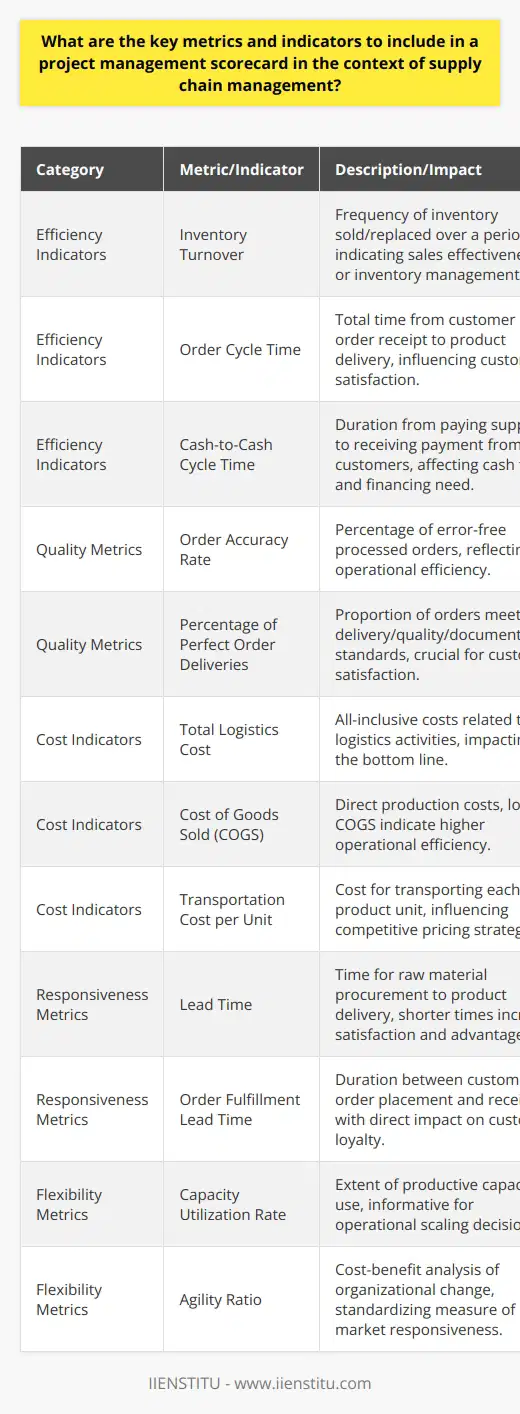
What is the relationship between a project management scorecard and overall supply chain strategy?
**Relationship between Project Management Scorecard and Supply Chain Strategy**
A project management scorecard is a comprehensive tool that evaluates the success of a project by measuring key performance indicators (KPIs) related to budget, time, quality, and stakeholder satisfaction. It plays a critical role in aligning the project objectives with the overall supply chain strategy by facilitating performance monitoring, control, and improvement initiatives.
**Key Performance Indicators Alignment**
The relationship begins with the selection of KPIs that are relevant to the supply chain strategy. This ensures that project teams focus on achieving strategic objectives, such as minimizing lead times, reducing costs, and enhancing reliability in order to achieve a competitive advantage. By defining clear KPIs, project managers can systematically assess their progress and implement corrective actions to better align with the supply chain strategy.
**Continuous Improvement Mechanism**
The project management scorecard fosters a culture of continuous improvement within the supply chain by routinely monitoring project performance and identifying areas that require further enhancement. This iterative process enables organizations to progressively refine their supply chain processes, enhancing efficiency and responsiveness to ever-changing market demands.
**Risk Management and Mitigation**
Effective risk management is essential to a successful supply chain strategy, as it allows organizations to proactively identify and mitigate potential issues before they escalate. The project management scorecard serves as a valuable risk management tool by providing a comprehensive overview of project performance, thus enabling decision-makers to address potential roadblocks and ensure that the supply chain remains resilient and adaptive.
**Communication and Collaboration**
A close working relationship between cross-functional teams is necessary for a cohesive and efficient supply chain. The project management scorecard facilitates communication and collaboration by providing a platform to review project performance, share best practices, and discuss potential improvement opportunities. This fosters a sense of shared accountability and encourages teams to work collectively towards achieving strategic supply chain goals.
In conclusion, the project management scorecard contributes significantly to the overall supply chain strategy by enhancing visibility and control over project performance, fostering a culture of continuous improvement, and promoting effective risk management and collaboration. By leveraging the scorecard as a strategic tool, organizations can effectively synchronize their project objectives with their long-term supply chain ambitions, ultimately driving greater efficiency, competitiveness, and profitability.
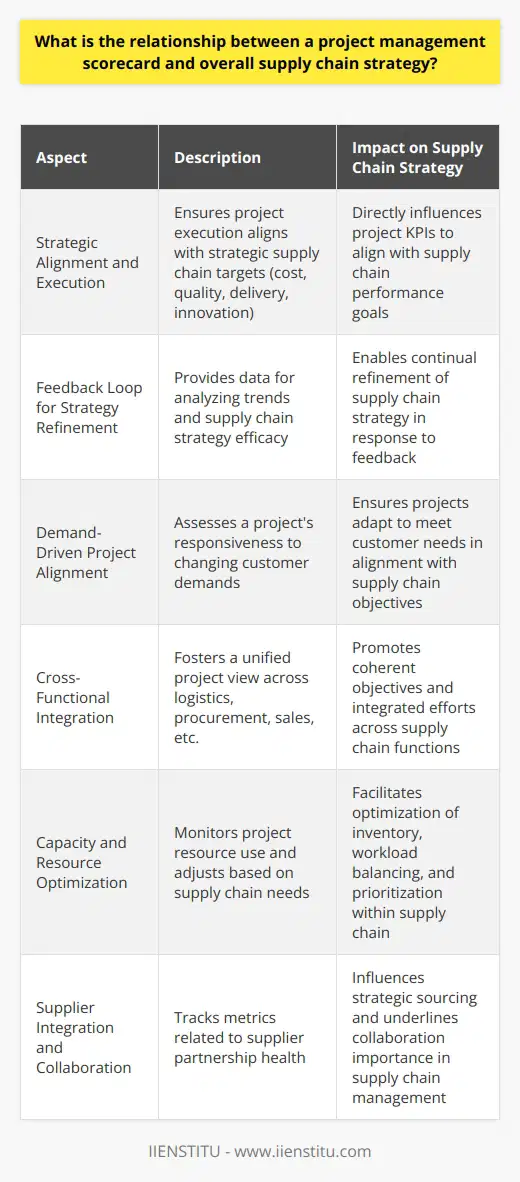
How can a well-designed supply chain scorecard contribute to continuous improvement and operational excellence?
Significance of a Supply Chain Scorecard
A well-designed supply chain scorecard plays a crucial role in continuous improvement and achieving operational excellence. By setting targets and key performance indicators (KPIs), businesses can measure their performance and identify areas for improvement. Monitoring these KPIs also ensures that the supply chain operates efficiently, thereby reducing costs and increasing customer satisfaction.
Effective Performance Measurement
The scorecard allows organizations to evaluate their supply chain's effectiveness, flexibility, and efficiency. This assessment enables managers to identify any bottlenecks or weaknesses, leading to well-informed decisions on investments and process improvements. It also helps in tracking the progress of these improvements, enabling the organization to adapt and continuously refine its processes.
Benchmarking and Goal Setting
Through benchmarking, companies can set realistic and attainable goals for their supply chain operations. By comparing their performance against industry standards and best practices, organizations can develop strategies to improve their processes and achieve superior results. This goal-setting process ensures that resources are allocated to the most critical tasks, fostering sustainable growth and competitive advantage.
Collaboration and Communication
A well-designed supply chain scorecard promotes increased collaboration and communication among various stakeholders, including suppliers, customers, and internal departments. This collaboration aids in identifying problems and addressing them proactively, reducing the risk of disruptions and inefficiencies. Furthermore, a transparent communication channel fosters trust and enhances relationships with partners, contributing to overall operational excellence.
Promotion of Accountability
Lastly, a supply chain scorecard emphasizes accountability by assigning responsibilities and setting expectations for each stakeholder in the process. The regular monitoring of KPIs ensures that any deviations from the established goals and objectives are quickly addressed, leading to corrective actions and improved performance. Ultimately, this comprehensive approach to performance measurement and reporting establishes a culture of accountability, promoting continuous improvement and striving for excellence within the organization.
In conclusion, a well-designed supply chain scorecard is a vital tool for achieving continuous improvement and operational excellence. It facilitates effective performance measurement, benchmarking, collaboration and communication, and promotes accountability, thereby leading to sustainable growth and competitive advantage for organizations.
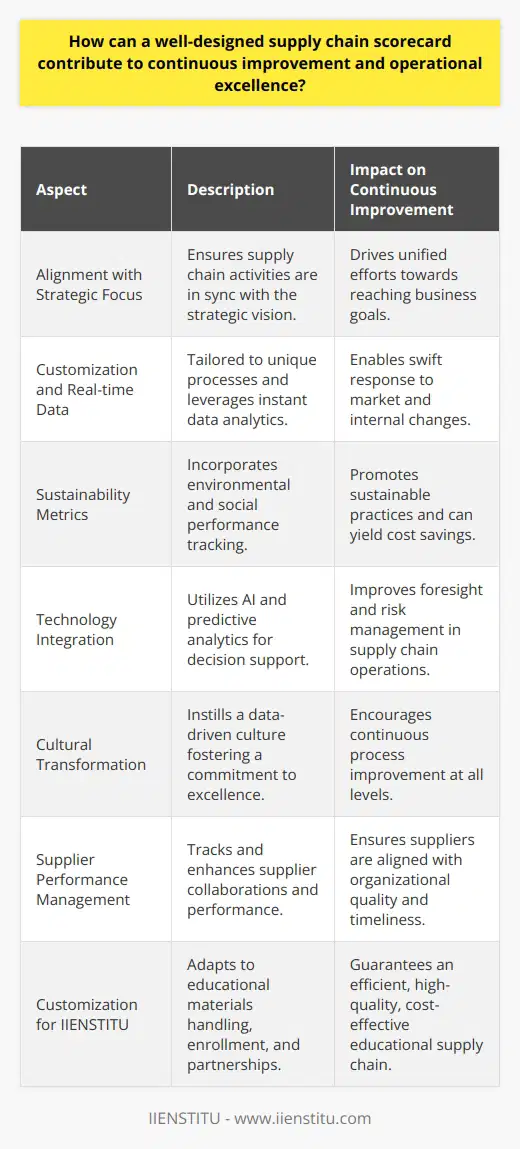
What are the challenges and potential pitfalls associated with implementing a project scorecard in supply chain management?
Challenges in Implementing Project Scorecards
One significant challenge associated with implementing a project scorecard is ensuring the alignment of its key performance indicators (KPIs) with the organization's overall strategic goals. This process can be time-consuming, and discrepancies between scorecards and organizational objectives may lead to inefficient resource allocation and decision-making.
Data Collection and Analysis
Another potential hurdle is obtaining accurate and consistent data. Ineffective data collection methods may yield unreliable information, impairing the scorecard's value as a performance measurement tool. Additionally, constant monitoring of the relevant KPIs is essential to gauge progress, requiring dedicated resources and expertise in data analysis. This can be a burden for organizations with limited resources.
Integration with Existing Systems
Integrating project scorecards with existing systems may pose a challenge due to potential incompatibilities, reluctance to adopt new practices, and resistance to change. Implementation may necessitate modifications to existing software, processes, or employee tasks, which could create disruptions and operational inefficiencies unless carefully managed.
Training and Adaptation
Employees, project managers, and stakeholders may require training and support to transition to a project scorecard system. This training may consume a considerable amount of time and resources, and without it, users may struggle to understand the scorecard's purpose and benefits, leading to resistance or disinterest.
Subjectivity and Bias
Although project scorecards aim to provide objective assessments, certain aspects, such as qualitative KPIs, are open to interpretation and susceptible to bias. The subjectivity of these measures may lead to the development of inaccurate or misleading conclusions, hindering the effective management of supply chain projects.
In conclusion, implementing a project scorecard within supply chain management presents several challenges, such as assuring alignment with organizational objectives, obtaining reliable data, integrating the scorecard into existing systems, providing adequate training for users, and mitigating subjectivity and bias. By addressing these challenges, organizations can effectively utilize project scorecards as an essential tool for evaluating and improving supply chain performance.
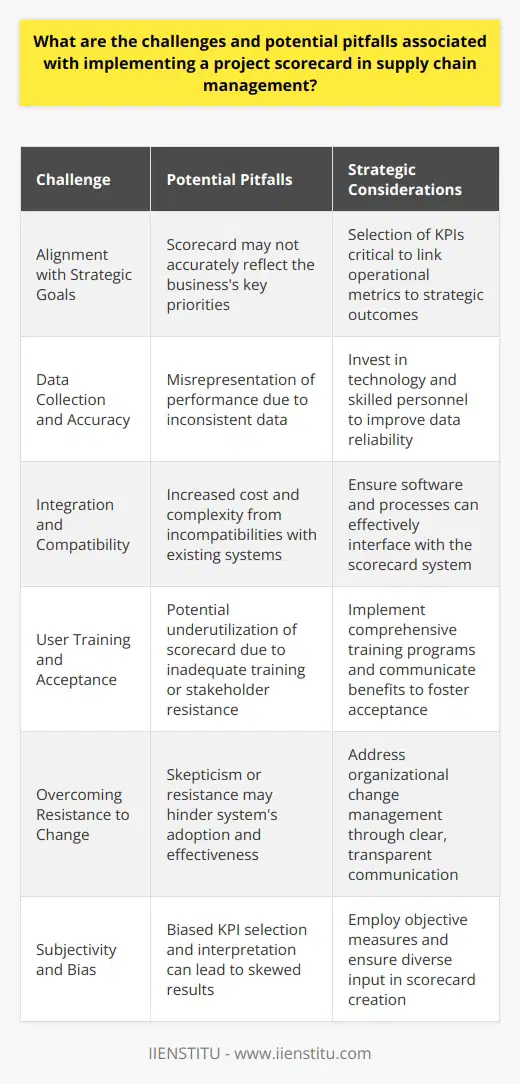
What is the significance of incorporating a scorecard in supply chain management decision-making processes?
Role of Scorecards in Decision-Making
The incorporation of scorecards in supply chain management (SCM) decision-making processes holds high significance in achieving organizational goals. Scorecards, comprised of key performance indicators (KPIs), offer valuable insights into the effectiveness and efficiency of different aspects of the supply chain. They aid in evaluating both short-term and long-term planning and support informed decision-making.
Enhancing Visibility and Transparency
As performance measurement tools, scorecards allow organizations to effectively monitor supply chain operations. They provide crucial visibility and transparency by tracking relevant metrics, such as order cycle time, on-time delivery, and inventory turnover. Consequently, this visibility encourages improvements and promotes the alignment of the supply chain with the company’s strategic objectives.
Enabling Continuous Improvement
Scorecards facilitate a continuous improvement cycle by serving as a mechanism to assess performance, identify areas of inefficiencies, and implement corrective actions. Providing real-time information about the supply chain’s performance empowers decision-makers in making timely, data-driven decisions. Furthermore, regular tracking of KPIs allows for the identification of trends and patterns, contributing towards the proactive management of risks and the optimization of resources.
Fostering Collaboration and Integration
The use of scorecards supports collaboration and integration among supply chain partners by establishing common performance goals and encouraging communication. Shared performance measurement standards and goals generate a sense of mutual accountability and contribute to continuous improvement. This collaborative approach leads to better decision-making and coordination across the supply chain, enhancing overall competitiveness and agility.
In conclusion, incorporating a scorecard in supply chain management decision-making processes is significant in terms of enhancing visibility, enabling continuous improvement, and fostering collaboration. The adoption of scorecards allows organizations to effectively monitor and improve their operations, ensuring alignment with strategic objectives and promoting sustainable success.
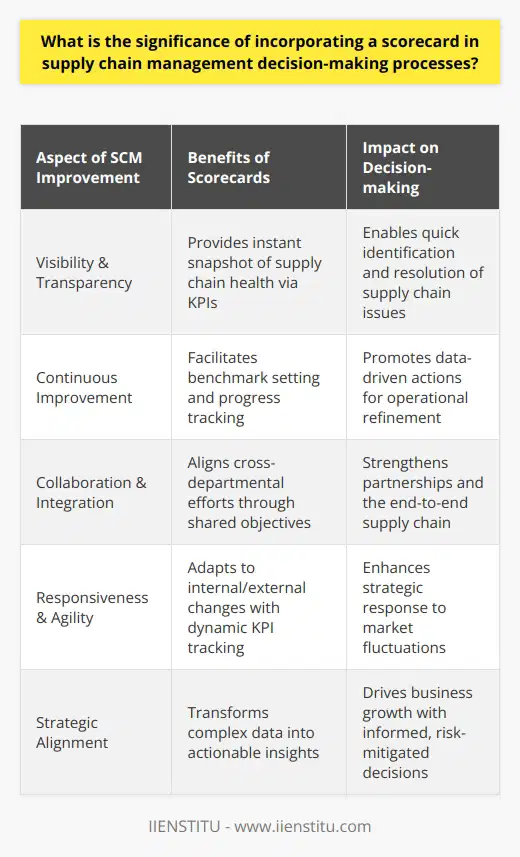
How can a project management scorecard be effectively integrated into existing supply chain management systems?
Developing a Strategy for Integration
To effectively integrate a project management scorecard into existing supply chain management systems, an organization must first develop a suitable strategy. This involves identifying key performance indicators (KPIs) that align with the organization's objectives and accurately measure the performance of its supply chain operations.
Addressing Data Collection and Analysis
Next, data collection and analysis methods must be established to ensure accurate measurement of the KPIs. This may involve utilizing quantitative methods such as surveys, inventory assessments, and shipment tracking, as well as qualitative methods like stakeholder interviews and assessments of supplier relationships.
Implementing the Scorecard within the System
Once the KPIs and data collection methods have been identified, the project management scorecard can be integrated within the supply chain management system. This can be achieved through embedding the scorecard into existing performance management frameworks, automating data collection, and ensuring that KPIs are visible and accessible to all relevant team members.
Training and Communication
To maximize the effectiveness of the scorecard, it is crucial to provide comprehensive training and communication to all relevant stakeholders. This includes instructing team members on how to use the scorecard, interpret the KPIs, and act upon the insights provided to improve supply chain performance.
Monitoring and Continuous Improvement
Lastly, organizations must establish a regular monitoring and review process to ensure that the project management scorecard remains effective and relevant to their evolving supply chain objectives. This involves conducting periodic assessments, updating the KPIs as necessary, and communicating any changes to the team.
In conclusion, integrating a project management scorecard into existing supply chain management systems demands strategic planning, effective data collection, seamless implementation, comprehensive training, and ongoing review. By implementing these steps, organizations can drive continuous improvement and enhance the overall performance of their supply chain operations.
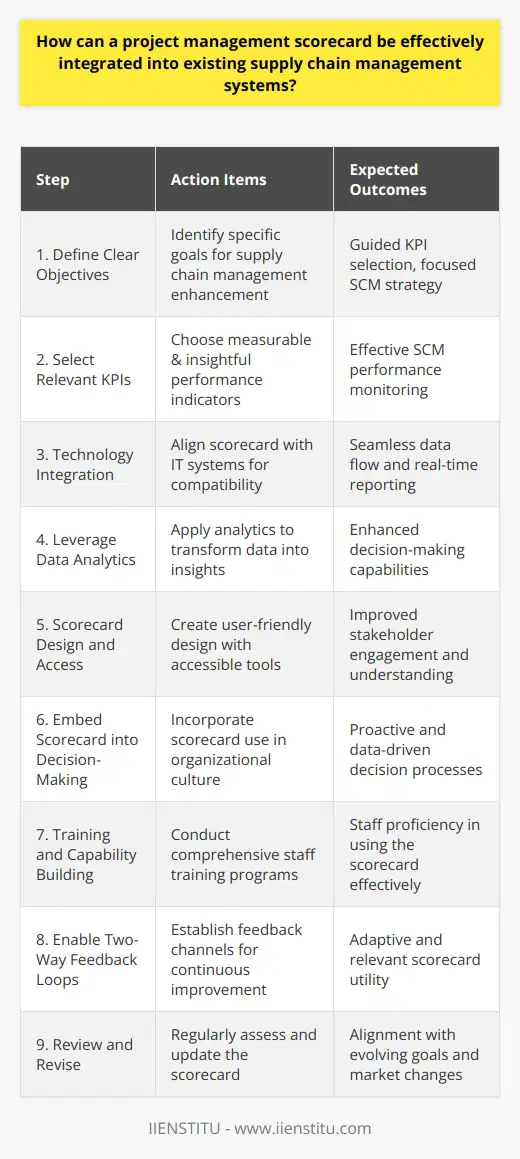
In what ways does a well-structured supply chain design impact a project scorecard's effectiveness and utility?
Supply Chain Design and Project Scorecard Relationship
A well-structured supply chain design can significantly impact a project scorecard's effectiveness and utility in various ways. Implementing an organized and efficient supply chain mitigates potential risks, improves collaboration among stakeholders, and supports a project's overall success. This, in turn, reflects the project scorecard as a valuable management tool.
Risk Reduction
A streamlined supply chain design reduces potential risks, such as disruptions and delays, that can derail a project's progress. An optimized design ensures all components and resources are available when needed, minimizing uncertainties and improving a project scorecard's accuracy in predicting outcomes.
Stakeholder Collaboration
Increased collaboration among all supply chain stakeholders results from a well-structured system. This collaboration fosters timely communication and effective decision-making, thereby enhancing the accuracy of project scorecard measures, such as cost, time, and quality parameters.
Cost Efficiency
Effective supply chain design minimizes overall project costs through optimized procurement, inventory management, and transportation. These cost savings, reflected in the project scorecard, demonstrate the project's financial efficiency and contribute to the justification of resource allocation.
Customer Responsiveness
A well-designed supply chain ensures timely delivery of products or services to customers, indicating effective scope management. This customer responsiveness is captured on the project scorecard and signifies a project's successful fulfillment of customer requirements.
Adaptability and Flexibility
Lastly, an organized supply chain design allows the project team to adapt to unforeseen changes or disruptions effectively. Incorporating flexibility in the design supports better decision-making, maintaining the project scorecard's reliability in guiding and evaluating project success.
In conclusion, a well-structured supply chain design plays a crucial role in enhancing a project scorecard's effectiveness and utility. The resulting risk reduction, stakeholder collaboration, cost efficiency, customer responsiveness, and adaptability all contribute to a more informed and reliable project management tool, ultimately supporting overall project success.
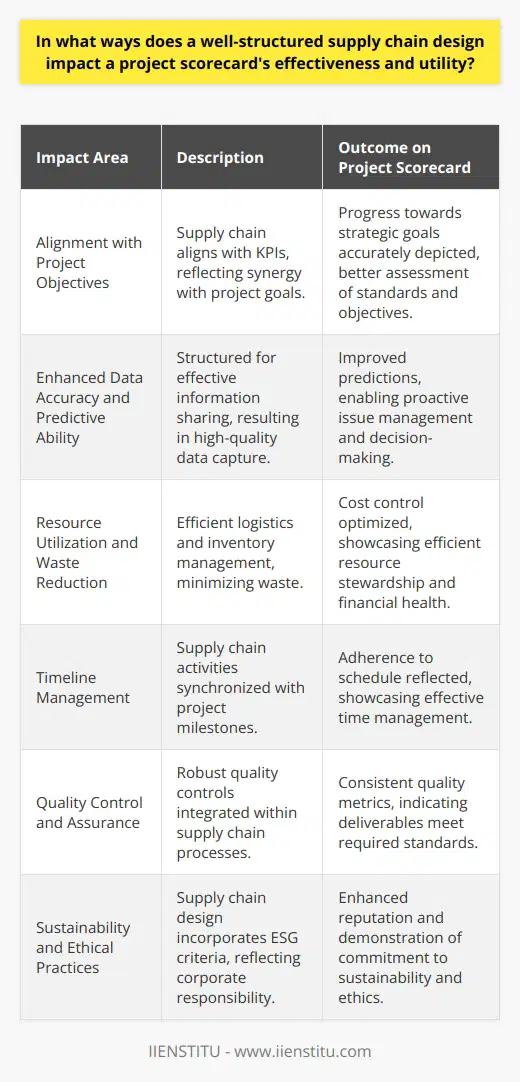
What is the purpose and benefits of utilizing a scorecard in supply chain management?
Purpose of a Scorecard in Supply Chain Management
A scorecard serves as a strategic planning tool in supply chain management, aimed at measuring and improving performance. It helps organizations align their supply chain objectives with overall business goals, ensuring efficient resource allocation and effective decision-making.
Benefits of Utilizing a Scorecard
Enhanced Performance Measurement
A scorecard allows organizations to track key performance indicators (KPIs), evaluating operational success and identifying areas needing improvement. This data-driven approach enables informed decision-making and targeted performance enhancement strategies.
Improved Supply Chain Visibility
Scorecards provide an overview of the entire supply chain, from suppliers to customers. This increased visibility promotes collaboration and communication, ensuring that each process step is optimized and aligned with the overall strategy.
Balanced Approach
Scorecards consider financial, customer, process, and learning (innovation) perspectives. This comprehensive view enables organizations to assess the impact of their actions on all stakeholders, promoting a balanced approach to supply chain management.
Enhanced Risk Management
By monitoring KPIs, a scorecard helps identify potential risks in the supply chain, allowing proactive risk mitigation strategies. This risk assessment results in enhanced resilience, improved business continuity, and reduced vulnerability to disruptions.
Fosters Continuous Improvement
Scorecards encourage continuous improvement by setting performance targets and regularly evaluating results. This feedback loop promotes incremental enhancements and cultivates a culture of excellence in supply chain management.
Promotes Collaboration and Accountability
With a scorecard in place, supply chain partners are clearer about their responsibilities and roles. It enhances accountability and collaboration amongst stakeholders, resulting in seamless coordination and improved performance.
Facilitates Goal Alignment
A scorecard enables organizations to align their supply chain objectives with broader business goals. This ensures that supply chain management strategies contribute effectively to the company's overall success.
In conclusion, utilizing a scorecard in supply chain management offers numerous benefits, including enhanced performance measurement, improved visibility, balanced decision-making, proactive risk management, and continuous improvement. Moreover, it fosters collaboration, accountability, and goal alignment, ensuring a strategic approach to managing the increasingly complex and global supply chain environment.
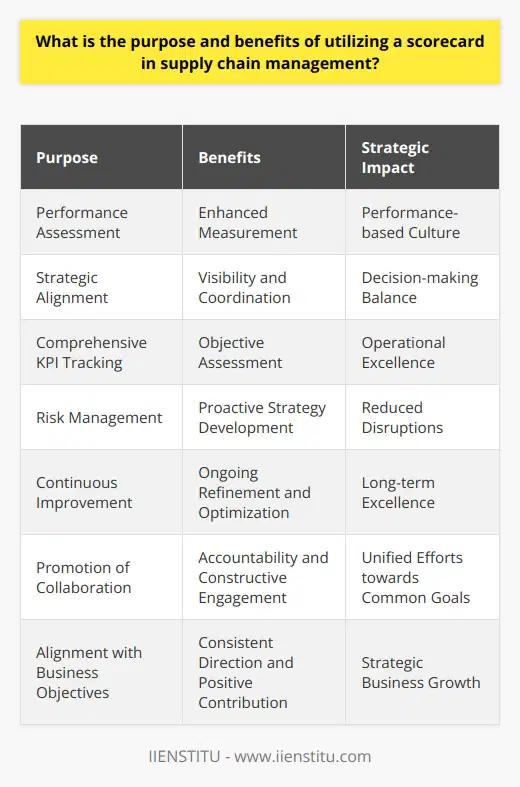
How can a project management scorecard be adapted to different types of supply chain projects and industries?
Adapting to Various Supply Chain Projects
A project management scorecard can be customized for different types of supply chain projects by identifying the key performance indicators (KPIs) specific to each project type. While some KPIs are standard across industries, such as cost, time, and quality, others vary depending on the supply chain project's nature. For instance, KPIs for a procurement project may include supplier lead time and order accuracy, while those for a logistics project might involve transportation costs and delivery time.
Industry-Specific KPIs Integration
To adapt a project management scorecard to different industries, one must identify the vital industry-specific KPIs. Consider the pharmaceutical industry, where regulatory compliance and product safety take precedence. Here, the scorecard should emphasize KPIs related to documentation, training, and adherence to guidelines. On the other hand, in the fast-moving consumer goods industry, focus on KPIs like inventory turnover, demand forecasting accuracy, and customer satisfaction is crucial for a successful supply chain project.
Customizing Scorecard Metrics
The project management scorecard can be further adjusted by customizing the weighting of each KPI, depending on the industry and project's priorities. For example, within the construction sector, factors like timely completion and cost control might have a higher weight, while factors like environmental impact and resource efficiency could be more important for green energy projects. By giving different weights to various KPIs, a project management scorecard can be tailored to fit the unique requirements of different supply chain projects and industries.
Incorporating Stakeholder Perspectives
To ensure a comprehensive project management scorecard, incorporating feedback from various stakeholders is essential. By engaging team members, suppliers, clients, and other stakeholders in the KPI selection and prioritization process, the scorecard will better reflect the project's unique challenges and objectives. Gaining stakeholder buy-in also fosters a collaborative approach, ensuring that project goals are aligned and understood by everyone involved.
Continuous Improvement and Adaptation
Lastly, a project management scorecard should remain adaptable and evolve throughout the project life cycle. As new data and feedback become available or when project priorities change, update the scorecard to reflect the latest information. Such flexibility ensures the scorecard remains a relevant and valuable tool in managing different types of supply chain projects across various industries.
In conclusion, a project management scorecard's adaptability to different supply chain projects and industries can be ensured by identifying appropriate KPIs, customizing the weighting of metrics, incorporating stakeholder feedback, and periodically updating the scorecard. By doing so, project managers can have a versatile tool to gauge performance and make informed decisions throughout the project life cycle.
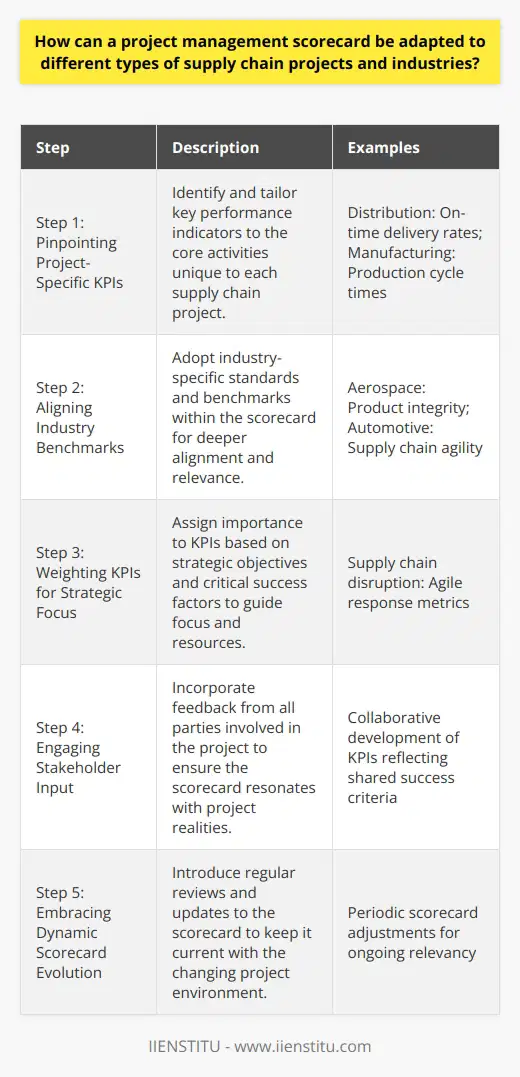
To what extent should external factors, such as sustainability and risk management, be incorporated into a supply chain scorecard?
Incorporating Sustainability and Risk Management
The incorporation of external factors, particularly sustainability and risk management, into supply chain scorecards is essential in ensuring comprehensive and efficient supply chain management. A vital reason for advocating for their inclusion is the increasing importance global organizations and consumers place on sustainable practices. By integrating these factors into the assessment criteria, companies can prioritize environmental, social, and economic responsibility alongside other supply chain performance measures.
Benefits of Sustainable Supply Chain Practices
Including sustainability into the scorecard allows companies to assess the ecological and social impact of their supply chain activities. In turn, this encourages the adoption of environmentally friendly practices and addresses common issues such as waste, pollution, and resource management. Additionally, this inclusion can lead to better stakeholder relations, as it showcases a company's commitment to ethical and sustainable practices, which are increasingly influential factors for investors and customers.
Addressing Risk Management in Supply Chain Scorecards
Similarly, risk management should be incorporated into the evaluation criteria to ensure proactive identification, assessment, and mitigation of potential disruptions in the supply chain. With globalization and recent events, such as the COVID-19 pandemic, supply chain disruptions have become more prevalent and complex, requiring companies to have a robust risk management plan in place. Incorporating risk management into the scorecard enables companies to effectively manage, monitor, and reduce potential risks, ultimately leading to more resilient and reliable supply chains.
Performance Tracking and Continual Improvement
Monitoring sustainability and risk management through scorecards allows companies to establish clear benchmarks, evaluate their progress, and improve these areas continuously. When these external factors are quantitatively and qualitatively measured, companies can identify gaps and opportunities for improvement in their supply chain processes. This not only ensures ongoing progression in sustainability and risk management but also drives operational efficiency across the entire supply chain.
In conclusion, the integration of sustainability and risk management into supply chain scorecards is crucial in today's complex and competitive business environment. By accounting for these external factors, companies can align their supply chain management with broader organizational goals and stakeholder expectations, ultimately enhancing their competitive advantage and fostering long-term success.

What is the role of the balanced scorecard approach in measuring supply chain performance?
Role of Balanced Scorecard Approach
In measuring supply chain performance, the Balanced Scorecard approach plays a pivotal role. It provides a framework for businesses to track and control their operations. This monitoring mechanism aligns the organizational strategies with the operational processes.
Focus Areas
Four traditional perspectives make up the Balanced Scorecard: financial, customer, internal process, and learning & growth. It evaluates supply chain performance across these four dimensions. Each perspective highlights different aspects of a supply chain's overall performance.
Financial Perspective
The financial perspective assesses the cost efficiency of supply chain operations.
Customer Perspective
The customer perspective measures the ability of the supply chain to meet customer demands.
Internal Process Perspective
For the internal process perspective, it gauges the effectiveness of internal supply chain processes.
Learning and Growth Perspective
Through the learning and growth perspective, the assessment is on the adaptability of a supply chain to change and innovation.
Organizational Alignment
The balanced scorecard allows businesses to align their operational goals with the supply chain processes. This alignment ensures seamless operations and greater proficiency across various departments.
Performance Indicators
The balanced scorecard uses Key Performance Indicators (KPIs) to measure the performance. These KPIs give managers a comprehensive understanding of their supply chain's status and areas of improvement.
Proactive Decision Making
The balanced scorecard enables proactive decision making. It helps managers pinpoint any weak spots in the supply chain and take corrective action in a timely manner.
In summary, the Balanced Scorecard approach offers a multi-dimensional view of a supply chain's performance. Its comprehensive outlook provides companies with the tool for complete supply chain optimization.

How do you create a project management scorecard?
Defining the Objectives
Creating a project management scorecard starts with defining clear, measurable objectives. Equally important is aligning these objectives with the overarching goals of your organization. This alignment ensures the scorecard measures what matters most in terms of organizational strategy.
Identifying Key Performance Indicators
Next, identify the Key Performance Indicators (KPIs) that will track progress towards these objectives. Each objective needs to have at least one corresponding KPI. For example, if a project's objective is to increase customer satisfaction, an appropriate KPI might be the results of a customer satisfaction survey.
Establishing Measurement Methods
Once you have identified the KPIs, establish the method of measurement. This could range from financial metrics such as Return on Investment (ROI) to process efficiency metrics and beyond. It is worth noting that different projects might require different KPIs and measurement methods.
Setting Benchmarks
Subsequently, it's important to set benchmark values for each KPI. Benchmarks represent the desired level of performance. They serve as reference points against which actual performance gets assessed. It's important to set realistic yet challenging benchmarks to drive performance and continuous improvement.
Compiling the Scorecard
In compiling the scorecard, integrate all the above elements systematically. Entry fields should ideally include sections like project name, project objectives, KPIs, measurement methods and benchmarks. Then, you will enter the actual performance data regularly, and the scorecard will illustrate how well the project is doing in comparison to the benchmarks.
Updating and Reviewing
Finally, remember that the scorecard isn't a static document. You should update it regularly, ideally at significant project milestones. Regular reviews can help you figure out what's working and what requires adjustments. Moreover, conducting frequent reviews fosters a culture of accountability and continuous improvement.
To sum up, creating a project management scorecard involves careful planning, consistent tracking of chosen KPIs, and regular updates and reviews. If you handle it right, the scorecard can become a valuable tool in achieving project and organizational success.
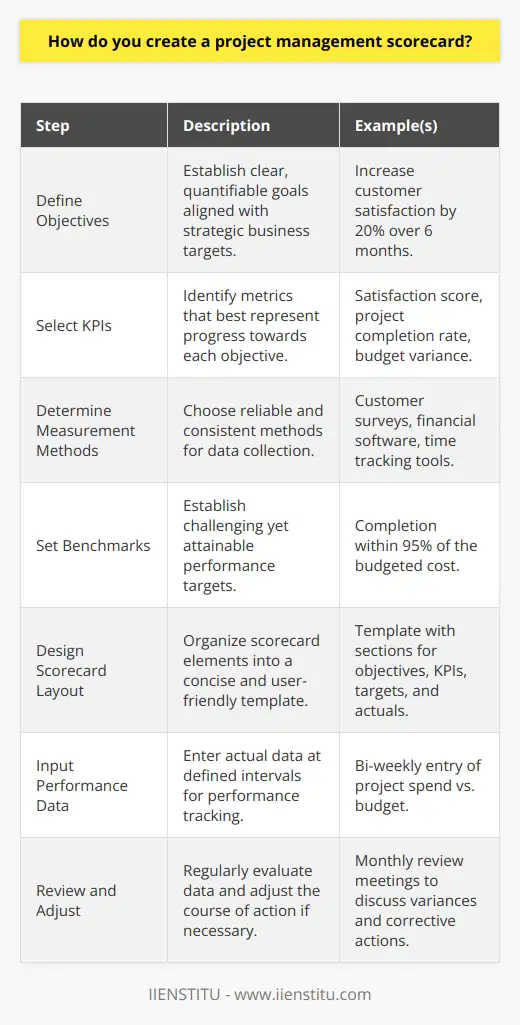
What is a best practice in creating a project scorecard?
Creating a Powerful Project Scorecard
A best practice in creating a project scorecard involves clearly defining project objectives first. Ambiguous goals can lead to ineffective measurements of success.
Selecting the Right Metrics
Next, it’s essential to select the right metrics. These should directly link to the project's goals. Irrelevant metrics dilute the effectiveness of the scorecard.
Setting Realistic Performance Targets
Once you select the right metrics, set realistic performance targets. These give a benchmark to measure project performance against. Arbitrary targets yield inaccurate measurements of success.
Use of Consistent Measurement Systems
Using consistent measurement systems makes for accurate comparison over time or across projects. Inconsistent measurements, on the other hand, lead to distorted views of project performance.
Balancing Leading and Lagging Indicators
The scorecard must balance leading and lagging indicators. Leading indicators predict future performance; lagging indicators evaluate past performance. A balance of both presents a complete picture.
Communicating Regularly
Regular communication keeps everyone informed about the project's progress. This helps to identify and tackle hurdles early before becoming big issues.
Aligning scorecard with Strategic Goals
A scorecard must align with organization's strategic goals. This alignment secures necessary support and ensures meaningful contributions towards overall business objectives.
Remember, an outstanding project scorecard offers an accurate, balanced, and timely snapshot of performance. Thus, these best practices can considerably enhance the project scorecard's utility and effectiveness.
